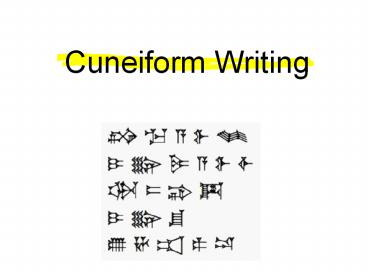Cuneiform%20Writing - PowerPoint PPT Presentation
Title: Cuneiform%20Writing
1
Cuneiform Writing
2
Overview
- Cuneiform, meaning "wedge," is the term applied
to a mode of writing which used a wedge-shaped
stylus to make impressions on a clay surface, and
also on stone, metal, and wax. - Most of the clay tablets were sun-baked, making
surviving tablets very fragile. - This technique originated in ancient southern
Mesopotamia and the earliest texts in cuneiform
script are about 5000 years old.
3
(No Transcript)
4
Life as a scribe
- Challenges
- Learning several thousand symbols
- The symbols represent words not letters
- Think about how many words you know
- Creating a tablet
- Storing the tablet
5
Scribes at work
6
Changes in Writing
- The Sumerian writing system during the early
periods was constantly in flux. The original
direction of writing was from top to bottom, but
for reasons unknown, it changed to left-to-right
very early on (perhaps around 3000 BCE). - This also affected the orientation of the signs
by rotating all of them 90 counterclockwise. - Another change in this early system involved the
"style" of the signs. The early signs were more
"linear" in that the strokes making up the signs
were lines and curves. But starting after 3000
BCE these strokes started to evolve into wedges,
thus changing the visual style of the signs from
linear to "cuneiform".
7
- Cuneiform written in horizontal lines
8
Evolution of Cuneiform
9
Evolution of Cuneiform
10
(No Transcript)
11
Understanding Cuneiform
- Knowledge of cuneiform was lost until AD 1835,
when Henry Rawlinson, an English army officer,
found some inscriptions on a cliff in Persia. - Carved in the reign of King Darius of Persia
(522-486 BC), they consisted of identical texts
in three languages Old Persian, Babylonian and
Elamite. - After translating the Persian, Rawlinson began to
decipher the others. By 1851 he could read 200
Babylonian signs. (That is 16 years of work!)
12
More Numbers
13
Cuneiform Numbers
14
Roller used to make multiple copies































